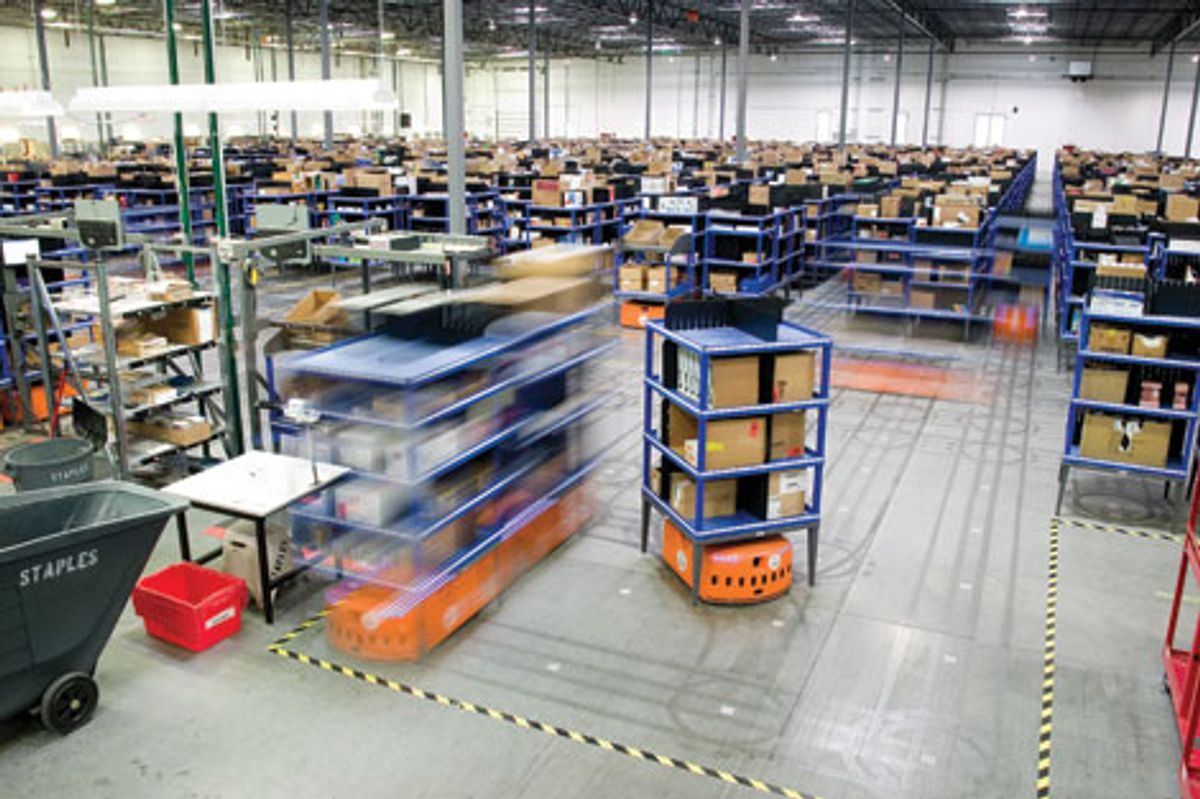Amazon announced today that it is acquiring Kiva Systems, a North Reading, Mass.-based company that invented a revolutionary way of managing vast warehouses by using fleets of mobile robots to sort, organize, and transport inventory.
Amazon agreed to acquire all of the outstanding shares of Kiva for approximately US $775 million in cash. The companies expect to close the acquisition in the second quarter of 2012.
“Amazon has long used automation in its fulfillment centers, and Kiva’s technology is another way to improve productivity by bringing the products directly to employees to pick, pack, and stow,” Dave Clark, Amazon.com’s vice president of global customer fulfillment said in a statement.
First, let’s put this deal into perspective. I wrote that last week’s news that Japan’s Softbank was acquiring French robot maker Aldebaran for $100 million would “send a ripple of excitement through the robotics community.” So how to describe the impact of Kiva’s much larger acquisition? A tsunami of excitement? This is clearly huge -- probably the biggest robotics deal in recent memory (at least my memory).
And what does Kiva do that got Amazon so interested? Basically, Kiva has reinvented the centuries-old warehouse business, transforming distribution centers -- which previously relied on slow-moving humans to walk around picking and packing goods -- into a buzzing hive of superefficient, tireless robotic workers.
I visited Kiva four years ago, when the company was based in Woburn, Mass., and wrote a long feature, titled “Three Engineers, Hundreds of Robots, One Warehouse,” describing how the company came about and how it arrived at some truly ingenious technical solutions. The company has rapidly taken off, signing up customers like Staples, Walgreens, Gap, Toys ‘R’ Us, Office Depot, and Zappos -- a trajectory that now culminates with the Amazon acquisition.
I wonder what Kiva’s customers, some of which compete directly with Amazon in some areas of retail, think of the acquisition. Will Kiva be able to continue helping them, or will Amazon demand full attention as it automates its own warehouses? I’ve contacted Kiva but haven’t received an official answer yet.
But let’s put business aside for now; one thing that the Kiva story seems to highlight well is the potential of basic research and technological innovation.
“This is a great validation of the innovation model that I have been encouraging for years as a university professor: Engage in research that pushes the boundary of autonomous systems capabilities, without worrying about whether it has a direct or immediate application,” Raffaello D’Andrea, an ETH Zurich professor and one of Kiva’s co-founders, told me in an email. (D’Andrea is an IEEE Fellow and a member of IEEE Spectrum‘s editorial advisory board.)
“The robotic aspects of Kiva Systems had their genesis in robot soccer: Many of Kiva’s key, initial technical hires were former Cornell RoboCup team members, with expertise in dynamics and control, mechanical engineering, electrical engineering, and computer science,” he said. “In addition, one of Kiva’s earliest hires was a collaborator on the interactive art installation ‘The Table,’ currently part of the National Gallery of Canada’s permanent collection. Who would have thought that autonomous, soccer-playing robots, or that a robotic artwork, would enable a business like Kiva Systems?”
Yes, who would have thought that robot soccer would one day lead to a $700 million idea? It’s always great to see innovation work out in a major way, especially in robotics, a field that has long captured people’s imagination but whose world-changing potential is still waiting to be unlocked.
D’Andrea is optimistic. “Times are changing,” he said. “Mobile robots are no longer seen as lab projects.”
Erico Guizzo is the Director of Digital Innovation at IEEE Spectrum, and cofounder of the IEEE Robots Guide, an award-winning interactive site about robotics. He oversees the operation, integration, and new feature development for all digital properties and platforms, including the Spectrum website, newsletters, CMS, editorial workflow systems, and analytics and AI tools. An IEEE Member, he is an electrical engineer by training and has a master’s degree in science writing from MIT.



